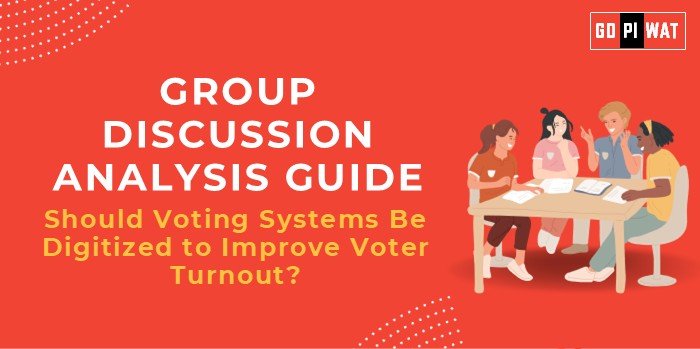📋 Group Discussion (GD) Analysis Guide: Should Voting Systems Be Digitized to Improve Voter Turnout?
🌐 Introduction to the Topic
- 📖 Context: Low voter turnout remains a significant challenge for democracies worldwide. Digitizing voting systems, including online and electronic voting, offers a potential solution by enhancing accessibility and convenience.
- 💡 Background: Countries like Estonia have successfully implemented digital voting, but concerns about cybersecurity and digital literacy persist. The debate raises questions about whether technology can truly enhance democratic participation.
📊 Quick Facts and Key Statistics
- 📉 Global Voter Turnout Decline: The average voter turnout in national elections fell from 68% in the 1960s to 63% in the 2010s (IDEA, 2023).
- 💻 Digital Voting Success: Estonia reports 47% of voters using online voting in its 2023 elections, with a turnout rate of 77%.
- 🌍 Accessibility Gap: 1 billion people worldwide lack access to polling stations due to geographical and physical barriers (UNDP, 2023).
- ⚠️ Cybersecurity Threats: The 2020 US elections saw over 10 million attempted cyberattacks on voting infrastructure.
👥 Stakeholders and Their Roles
- 🏛️ Government Bodies: Oversee secure and inclusive implementation of digital voting systems.
- 🗳️ Electoral Commissions: Develop and enforce guidelines for technology adoption.
- 💼 Technology Providers: Create secure, user-friendly platforms.
- 🙋 Citizens: Engage with digital systems, requiring access and literacy.
- 🔒 Cybersecurity Experts: Ensure the resilience of voting systems against threats.
🏆 Achievements and Challenges
✨ Achievements:
- 🌐 Improved Accessibility: Digital voting enables participation from remote areas and by differently-abled individuals.
- ✅ Enhanced Convenience: Online systems reduce logistical barriers like long queues and travel time.
- 📜 Successful Models: Estonia’s digital voting has increased trust and participation over two decades.
- 💰 Cost Efficiency: Long-term savings on physical voting infrastructure.
⚠️ Challenges:
- 🔍 Cybersecurity Risks: Vulnerability to hacking and data breaches.
- 📉 Digital Divide: Excludes those lacking access to technology or digital literacy.
- 🤔 Trust Issues: Fear of manipulation or lack of transparency in digital systems.
- 🌐 Global Comparisons:
- ✅ Success: Estonia’s robust cyber protections and voter education programs.
- ⚠️ Challenges: Failed trials in countries like the Netherlands due to security concerns.
📄 Structured Arguments for Discussion
- 👍 Supporting Stance: “Digitizing voting systems will increase accessibility, reduce costs, and modernize the electoral process to engage more voters.”
- 👎 Opposing Stance: “Digital voting systems pose significant risks of cybersecurity breaches, potentially undermining trust in democratic processes.”
- ⚖️ Balanced Perspective: “While digital systems offer potential for higher turnout, their success depends on strong security measures and equitable access.”
💬 Effective Discussion Approaches
- 🎯 Opening Approaches:
- 📊 Cite data: “Countries like Estonia show how digital voting can increase voter turnout and trust.”
- 🌍 Highlight accessibility: “For 1 billion people facing voting barriers, digitization could be transformative.”
- 🤝 Counter-Argument Handling:
- ✅ Acknowledge risks but propose mitigations like blockchain technology.
- ⚖️ Emphasize hybrid models to ensure inclusivity and security.
🔎 Strategic Analysis of Strengths and Weaknesses
- 💪 Strengths: Accessibility, efficiency, environmental benefits (less paper use).
- ❌ Weaknesses: Cybersecurity risks, potential for disenfranchisement.
- 🌟 Opportunities: Blockchain for secure, transparent systems; pilot programs to refine implementation.
- ⚠️ Threats: Public skepticism, digital inequality.
🎓 Connecting with B-School Applications
- 🌍 Real-World Applications: Use cases in operations management, risk assessment, and technology-driven solutions.
- 📝 Sample Interview Questions:
- 💡 “How can technology address challenges in voting systems?”
- 🔒 “What safeguards are essential for successful digital voting implementation?”
- ✨ Insights for Students: Analyze risk management and technological innovation in complex systems.


